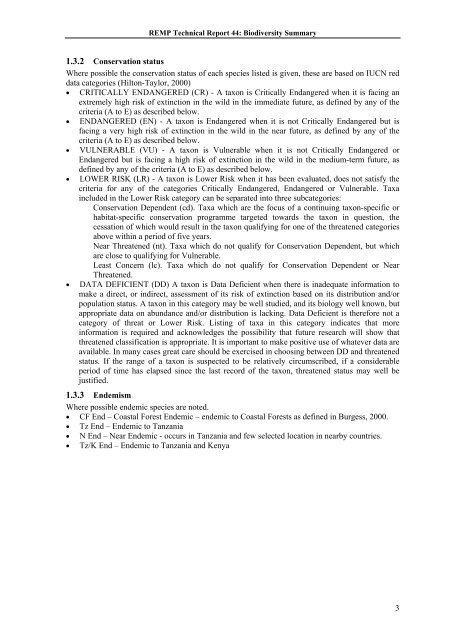Family / Scientific name - Coastal Forests of Kenya and Tanzania
Family / Scientific name - Coastal Forests of Kenya and Tanzania
Family / Scientific name - Coastal Forests of Kenya and Tanzania
You also want an ePaper? Increase the reach of your titles
YUMPU automatically turns print PDFs into web optimized ePapers that Google loves.
REMP Technical Report 44: Biodiversity Summary<br />
1.3.2 Conservation status<br />
Where possible the conservation status <strong>of</strong> each species listed is given, these are based on IUCN red<br />
data categories (Hilton-Taylor, 2000)<br />
�� CRITICALLY ENDANGERED (CR) - A taxon is Critically Endangered when it is facing an<br />
extremely high risk <strong>of</strong> extinction in the wild in the immediate future, as defined by any <strong>of</strong> the<br />
criteria (A to E) as described below.<br />
�� ENDANGERED (EN) - A taxon is Endangered when it is not Critically Endangered but is<br />
facing a very high risk <strong>of</strong> extinction in the wild in the near future, as defined by any <strong>of</strong> the<br />
criteria (A to E) as described below.<br />
�� VULNERABLE (VU) - A taxon is Vulnerable when it is not Critically Endangered or<br />
Endangered but is facing a high risk <strong>of</strong> extinction in the wild in the medium-term future, as<br />
defined by any <strong>of</strong> the criteria (A to E) as described below.<br />
�� LOWER RISK (LR) - A taxon is Lower Risk when it has been evaluated, does not satisfy the<br />
criteria for any <strong>of</strong> the categories Critically Endangered, Endangered or Vulnerable. Taxa<br />
included in the Lower Risk category can be separated into three subcategories:<br />
Conservation Dependent (cd). Taxa which are the focus <strong>of</strong> a continuing taxon-specific or<br />
habitat-specific conservation programme targeted towards the taxon in question, the<br />
cessation <strong>of</strong> which would result in the taxon qualifying for one <strong>of</strong> the threatened categories<br />
above within a period <strong>of</strong> five years.<br />
Near Threatened (nt). Taxa which do not qualify for Conservation Dependent, but which<br />
are close to qualifying for Vulnerable.<br />
Least Concern (lc). Taxa which do not qualify for Conservation Dependent or Near<br />
Threatened.<br />
�� DATA DEFICIENT (DD) A taxon is Data Deficient when there is inadequate information to<br />
make a direct, or indirect, assessment <strong>of</strong> its risk <strong>of</strong> extinction based on its distribution <strong>and</strong>/or<br />
population status. A taxon in this category may be well studied, <strong>and</strong> its biology well known, but<br />
appropriate data on abundance <strong>and</strong>/or distribution is lacking. Data Deficient is therefore not a<br />
category <strong>of</strong> threat or Lower Risk. Listing <strong>of</strong> taxa in this category indicates that more<br />
information is required <strong>and</strong> acknowledges the possibility that future research will show that<br />
threatened classification is appropriate. It is important to make positive use <strong>of</strong> whatever data are<br />
available. In many cases great care should be exercised in choosing between DD <strong>and</strong> threatened<br />
status. If the range <strong>of</strong> a taxon is suspected to be relatively circumscribed, if a considerable<br />
period <strong>of</strong> time has elapsed since the last record <strong>of</strong> the taxon, threatened status may well be<br />
justified.<br />
1.3.3 Endemism<br />
Where possible endemic species are noted.<br />
�� CF End – <strong>Coastal</strong> Forest Endemic – endemic to <strong>Coastal</strong> <strong>Forests</strong> as defined in Burgess, 2000.<br />
�� Tz End – Endemic to <strong>Tanzania</strong><br />
�� N End – Near Endemic - occurs in <strong>Tanzania</strong> <strong>and</strong> few selected location in nearby countries.<br />
�� Tz/K End – Endemic to <strong>Tanzania</strong> <strong>and</strong> <strong>Kenya</strong><br />
3

















